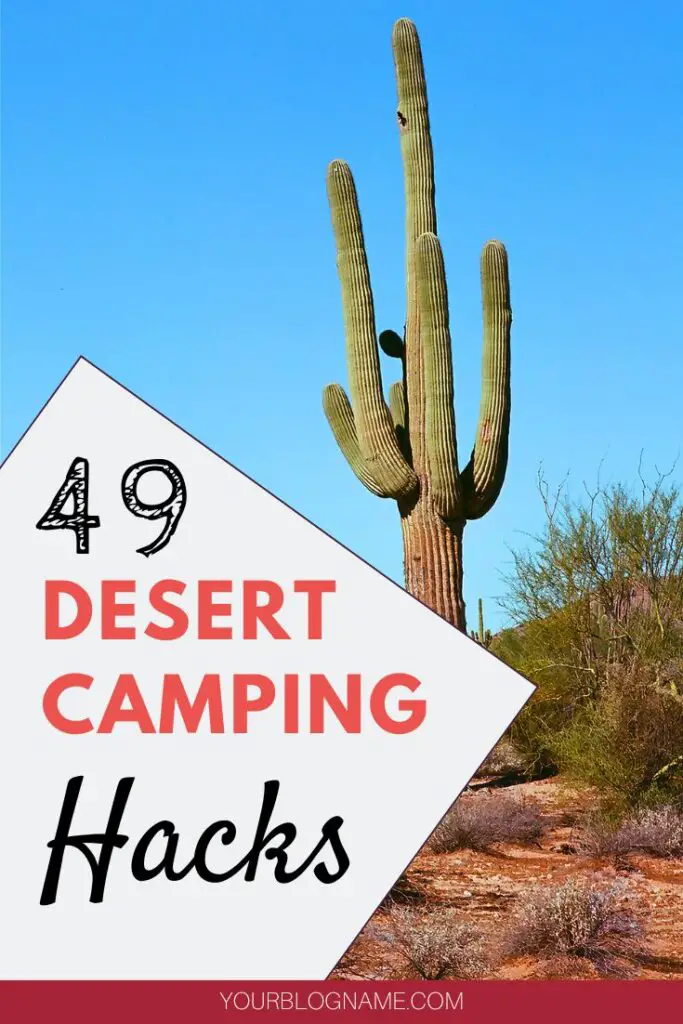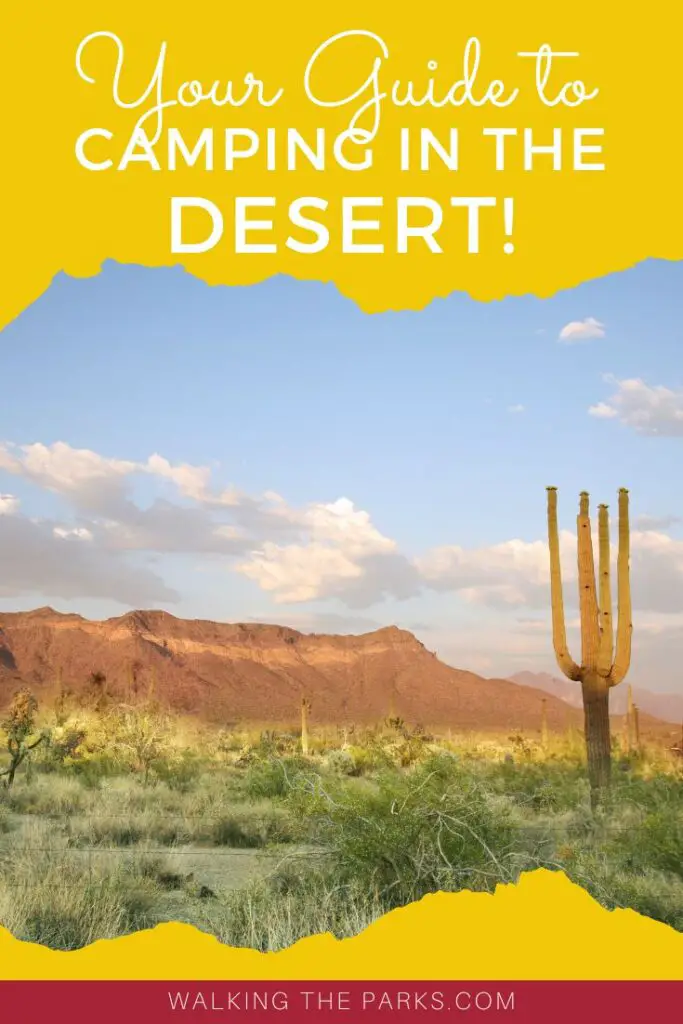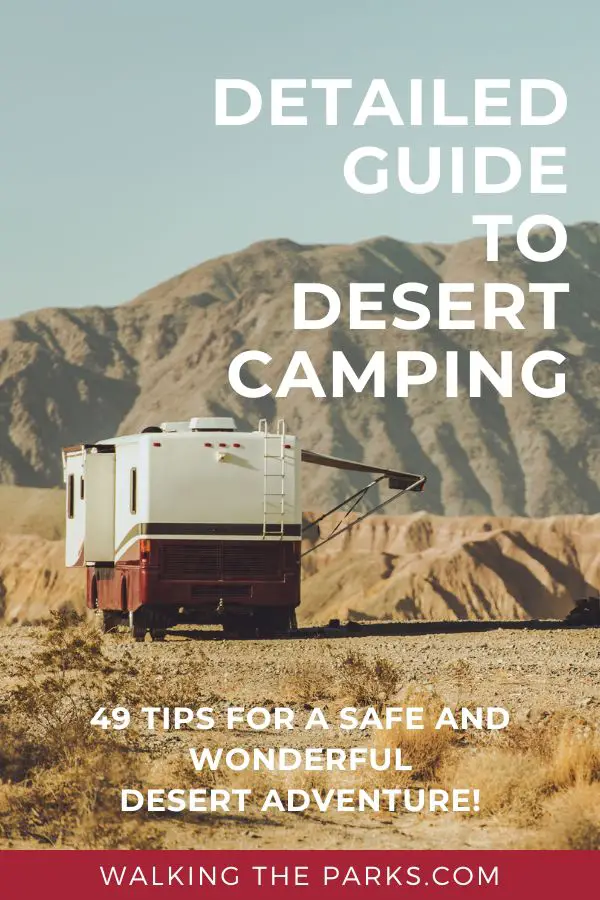Camping in the desert brings a unique twist to the idea of camping in the middle of nowhere. Not only are you usually far away from amenities and shopping, you are dealing with extreme heat and unusual critters.
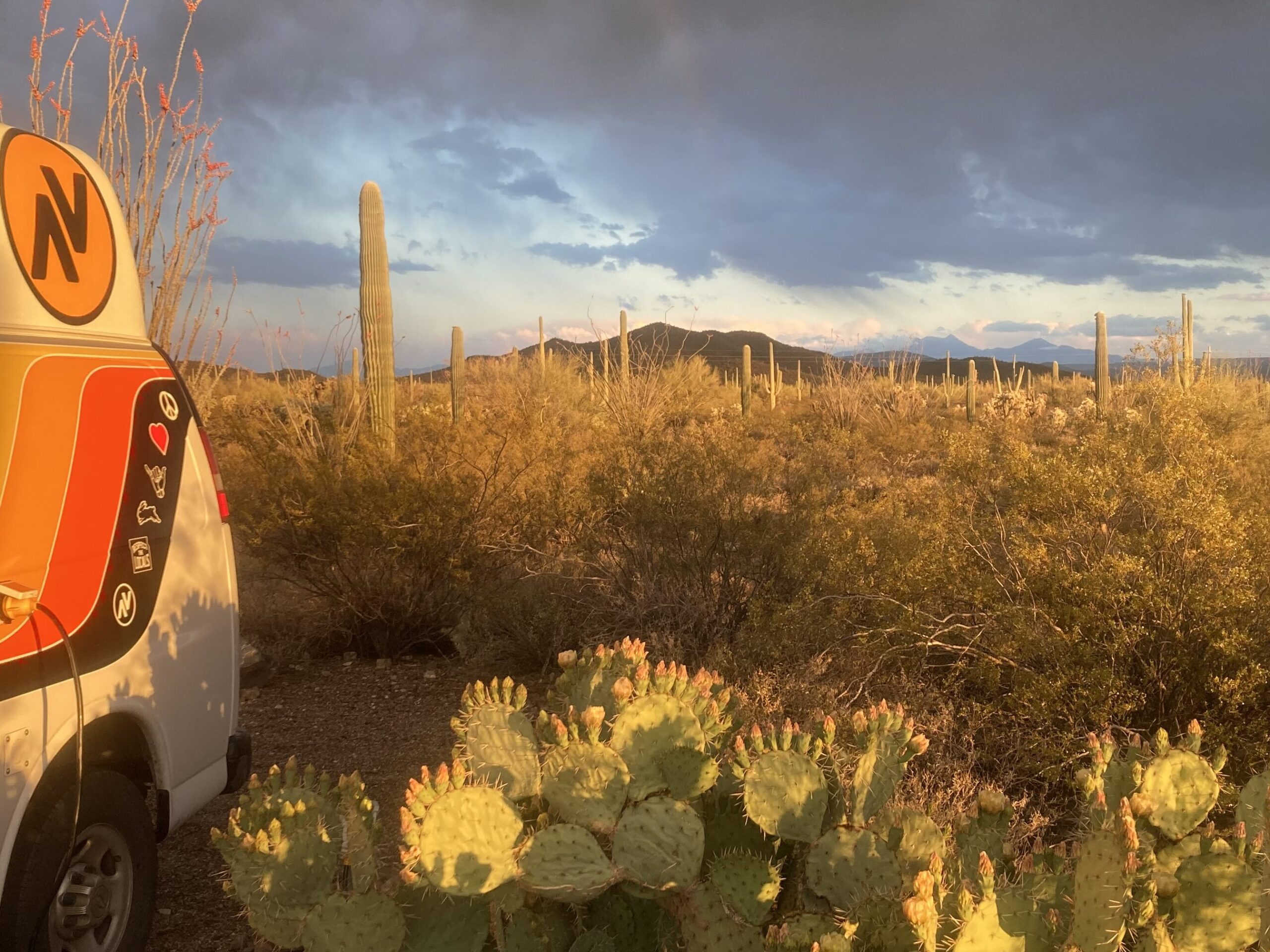
The desert is beautiful beyond belief. But it can also be a very dangerous place when you are camping and hiking. It’s a fine line between an amazing desert camping experience and a total camping disaster. That means there’s a lot to learn before your first desert camping trip. So we pulled together our best camping in the desert tips to help you plan your trip.
Although we’ve been camping for decades, we were caught a bit off guard by some things on our first desert camping trip several years ago. You don’t always realize how different camping in the Rockies is from camping in the Utah desert. I have to confess that I became so overwhelmed by the heat on our first desert adventure that we grabbed a last minute hotel one night. Since then we’ve learned to love the desert and have desert camped in a camper van as well as our favorite tent. We’ve accumulated quite a long list of tips to make your desert camping a success.
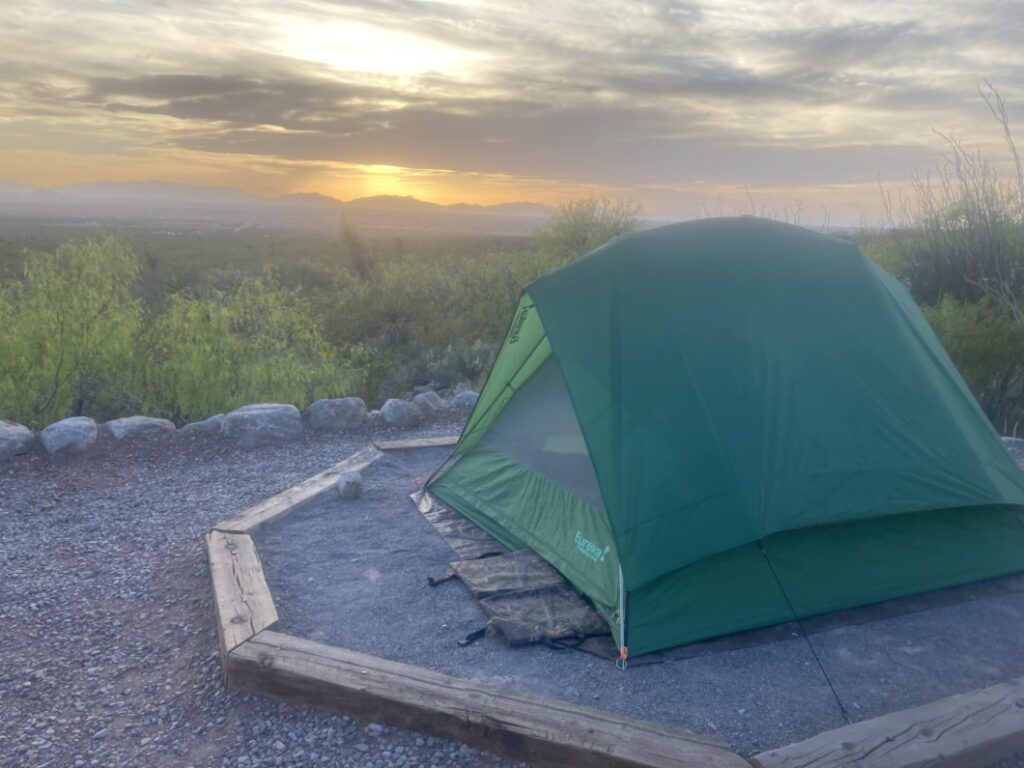
Let’s Start with Your Camp Site
1 Set Up on High Ground
You might be surprised to learn that flash floods put you at higher risk of death in the desert than either dehydration or poisonous critter bites (World Atlas).
Why? Because between rains, creek beds (often called a wash) are very dry between rains. All the water has soaked into the desert soil. They often look like really great hiking trails. And a dry wash might even have random shade along the higher edges that appears to be the perfect camping site. However, when rain falls those dry beds can fill up in a matter of minutes with raging water. Even a distant heavy rain can quickly fill up the dry wash miles away.
So always set up your tent or camper on higher ground to avoid getting swept away by an unexpected rain. Use designated campsites when available, such as when BLM camping as these have been tested by hundreds of other campers.
2 Find Shade in the Land without Trees
Finding shade in the desert is easier said than done. But if you can capture a bit of shade your day at camp will be much more comfortable. As you select your site take into consideration any features that might create shade.
For example, we camped on a bluff near Big Bend National Park that continued to rise behind us on the Southwest side. That meant when we returned to camp in the evening, the sun had already dropped behind the higher ground, providing shade while we prepared camp dinner.
If you are lucky enough to find a tree, consider the angle of the sun and place your tent or camper to take advantage of as much shade as possible. You’ll be grateful for the little bit of shade that comes from a Saguaro Cactus or a Joshua Tree in the late afternoon.
3 Can’t Find Shade? Then Make Shade
If you can’t find shade, make shade! If you are car camping or in an RV, you can probably pack a traditional canopy. We really like this lightweight 12ft by 12ft canopy from REI because it is easy to pack.
However if backpacking or if space is tight consider using a lightweight tarp with your hiking poles as supports.
It’s important to have adequate guy lines to secure your canopy or tarp as desert winds can quickly turn that tarp into a balloon with one desert updraft. Don’t leave your shade tarp or canopy up when you are not at camp to avoid it blowing away.
For Tent Campers: Set Up Your Tent With Desert in Mind
4 Start with a Desert Friendly Tent
The desert is a harsh environment. Not only does your tent need to survive the hot sun, you’ll also find high winds crossing the desert. And don’t forget those little critters that would love to nap in your tent.
If you have the luxury of buying a tent just for desert camping, here are the key features to look for:
- Aerodynamic Shape – Obviously so it won’t blow away. But also so you won’t feel it shaking all night if a wind storm hits. Dome shaped tents are great for the desert because the wind will blow around them rather than try to go through them like a flat sided tent.
- Cooling or Heat Shield Technology – Modern designs work to reflect heat and keep the interior of tents cooler. These tents are more expensive, but if you plan to spend much time in the desert well worth the investment. The cooler temps also work well to shade you for afternoon naps.
- Light Colored or Reflective Tent – If you can’t justify the expense of the technology, then at least make sure your tent is light colored so it reflects the heat rather than absorbs it.
- Ventilation – Let that breeze through for natural cooling. Mesh is your friend. A front and back door or window with a mesh lining will allow the breeze to keep you cool.
- Secure Floor to Keep Critters Out – Many backpackers love the lighter weight of floorless tents. However in the desert you’ll be better off with a tent that seals up completely to keep critters out.
Check out these posts for gift ideas for your favorite campers!
- Incredible Camping Gift Ideas for Women
- Forty Super Fun Camping Gift Ides for Kids
- Best Gift Ideas for RV Lovers that Have Everything
5 Properly Anchor Your Tent in the Desert Sand
A desert windstorm could keep you away all night shaking your tent. The solution is to properly anchor your tent. We’re often lazy about using all the guy lines when camping in the woods to get camp set up quickly. Well, desert camping is not the time to skip securing those lines.
Surprisingly, desert sand is often hard and rocky, not soft and squishy like a beach. If your campsite has firm ground then your regular stakes should hold securely as long as you place them at a 45 degree angle pointing away from your tent. Never put your stakes into the ground straight down because they will pull right out in the wind.
But then, many campsites will have soft sand and that requires a little more work to secure your guy lines. The most common technique is to use a deadman. That means wrapping the end of your guy line around a large flat object (anything from aluminum foil to a flat rock). Then bury that object by laying it flat in a large hole that 8-12 inches dep in the sand. If possible stack rocks on top of the filled in hole to add extra weight. The weight of the sand and rocks on top of the flat surface will hold your tent securely in the wind.
6 Let the Breeze Cool You – Position Tent based on Wind Direction
On our recent trip to the deserts of West Texas, we wanted a bigger tent for comfort so took our old reliable triangle shaped Eureka. (We love this tent!) So to avoid fighting the wind, we positioned the tent so the wind could blow right through the mesh front door and out the back window. We also left the rain fly off most nights which exposed more mesh, allowing more air to move through.
Tips for a Great Night’s Sleep in the Desert
7 Pack a USB Rechargeable Fan
One of the smartest things I did on our Texas/New Mexico Desert Road Trip was to pack this USB battery powered fan. It’s much bigger than the usb fans you attach to your laptop. The thing could move some air. We hung it in our tent at night and ran it for a few hours until the temperatures dropped. Sweet!
8 Select a Versatile Sleeping Bag
Night temperatures in the desert can vary greatly. You know it’s going to be a lot cooler than the day, but how much is hard to predict. There are so many environmental variables that effect how much the temperature is going to drop.
As a rule of thumb, your sleeping bag for the desert should be able to keep you warm at least 60 degrees cooler than the expected day time temperatures. But know it probably won’t get that cold so you want to be comfortable at warmer temps too.
We pack a sheet for covering up when we first go to bed and the temps haven’t dropped much. You’ll find a sleeping bag that vents at the feet will also help you adjust your sleeping temperature.
9 Bring a Sleeping Mask
Ok, you left your rain fly off or your camper windows open to let the breeze through your tent but now that full moon is reflecting off the desert sand lighting up your campsite like mid afternoon. It’s really cool to watch the full moon for a little while… but then you need to go to sleep. So create your own darkness by slipping on a soft sleeping mask. You’ll find it much more comfortable than pulling yesterday’s stinky t-shirt over your face.
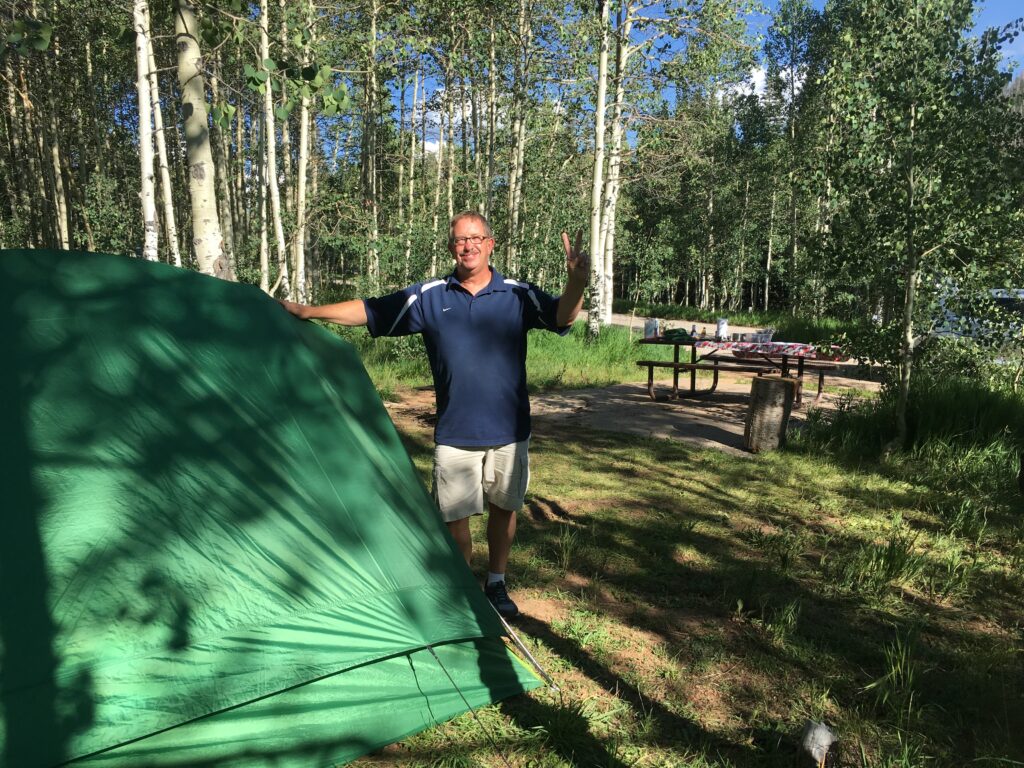
10 Consider Camping at Higher Elevations
My favorite trick for hot summer desert vacations is to look for higher elevations to camp. You’ll often find it 10 degrees cooler. For example when we did our 5 Utah National Parks Tour, we camped several nights in the desert mountains enjoying perfect sleeping temperatures in the 60s instead of the hotter night temperatures in Zion NP in the 80s.
Keep Your Camp Food Safe in the Desert
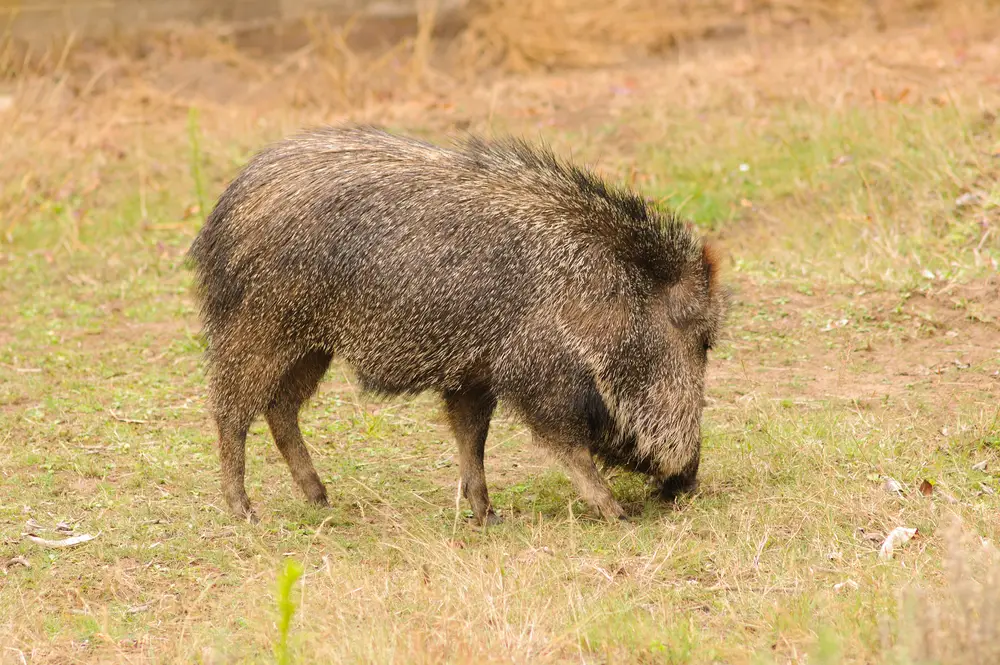
11 Protect Your Food From Desert Critters
The desert might seem like a desolate place, but animals and rodents come out as the night cools looking for food. Don’t let your food stash be their dinner. We’ve heard stories of javelinas destroying tents to get to the food. Coyotes will sneak into camp at night looking for treats. And rodents will chew holes in your backpack and tent corners if the smell treats.
Here’s a few tips to keep critters away from your food.
- If there’s a bear box in your campsite, there’s a reason why it was placed there. Bear boxes are a great deterrent to aggressive desert wildlife beyond bears, such as the javelina and coyote.
- Reusable odor proof storage bags for toiletries and food items reduces your risk significantly.
- Odor proof coolers are available at a variety of price ranges.
- Store coolers out of site. As crazy as it sounds, animals who learn to search for food in campsites also learn what a cooler looks like. If possible put your cooler in your vehicle and cover with a blanket so they can’t see it.
- Stainless-steel mesh bags will keep rodents from chewing through your food bag. These also keep larger animals from eating your food, but make sure you secure your bag so they don’t carry it away.
- Keep a clean camp. Wipe down tables, pick up dropped food and dispose of dishwashing water well away from your camp.
12 Cooking in the Desert at a Desert Camp Site
Bring a stove for cooking.
It’s most likely that you will not be allowed an open fire when camping in the desert. We think of the desert as a dry desolate place so it can be hard to image a raging wildfire. According to wildfire specialist Molly Hunter at the University of Arizona: wildfires are common in the desert. During the rainy season grasses and brush flourish. Then that foliage dries out creating fuel for fires. Throw in high winds in the spring and a fire can destroy land for miles.
13 Plan Mini Meals When Desert Camping
Desert heat can suppress your desire for food. While that might sound like an interesting diet opportunity, not eating in the desert is dangerous. You burn more calories when it’s hot. Dr. John Higgins of the University of Texas Medical School says that’s because your heart is working harder to support your cardiovascular system. To stay healthy you need to eat more calories in the desert.
Eating many mini meals keeps your energy level even throughout the day. Your body will enjoy those small treats without feeling sluggish or repulsed by food.
14 Put a Reflective Tarp over Your Cooler
Even the best cooler can’t compete against the desert sun. We found putting an insulating blanket over the cooler and then topping that with a reflective tarp improved the life of our cooler.
15 Bring More Water than You Can Ever Imagine Needing
You’ll read a lot of articles that say drink 1 gallon of water per day when in the desert. But really that’s just a guess. How much water you need to stay hydrated depends upon your own metabolism, the level of heat and how much effort your are putting out. There is no magic formula.
That said, when planning your water for camping in the desert 1 gallon per day per person is a good place to start. Then double that number. Then you’ll have what you need for cooking, for strenuous hikes, for cooling down if you overheat, etc.
16 Carry Water with You Anytime you Leave Camp
NEVER leave camp without water. Even if you are only planning to walk a short distance to check out “that thing” you saw. Dehydration in the desert kills. You never know when that short walk will turn into something more. Just grab a water bottle!
17 Know Where to Get More Water
Before you head out on a desert camping trip, take a minute to research where you can restock on water in an emergency. Packing more water than you can possibly imagine ever needing doesn’t mean something can’t go wrong.
We never pass up an opportunity, like passing a ranger station, to refill our big water jugs. And it’s common for me to grab that one extra gallon of water in the grocery store just in case. I’d rather come home with full water jugs than run out.
We always have a reserve of water in our coolers. Rather than using gel freezer bags, I freeze large water jugs in advance and use those for cooler ice.
Also remember desert creeks and streams that are shown on maps will probably be dry. So research rivers to determine if they usually have water all year.
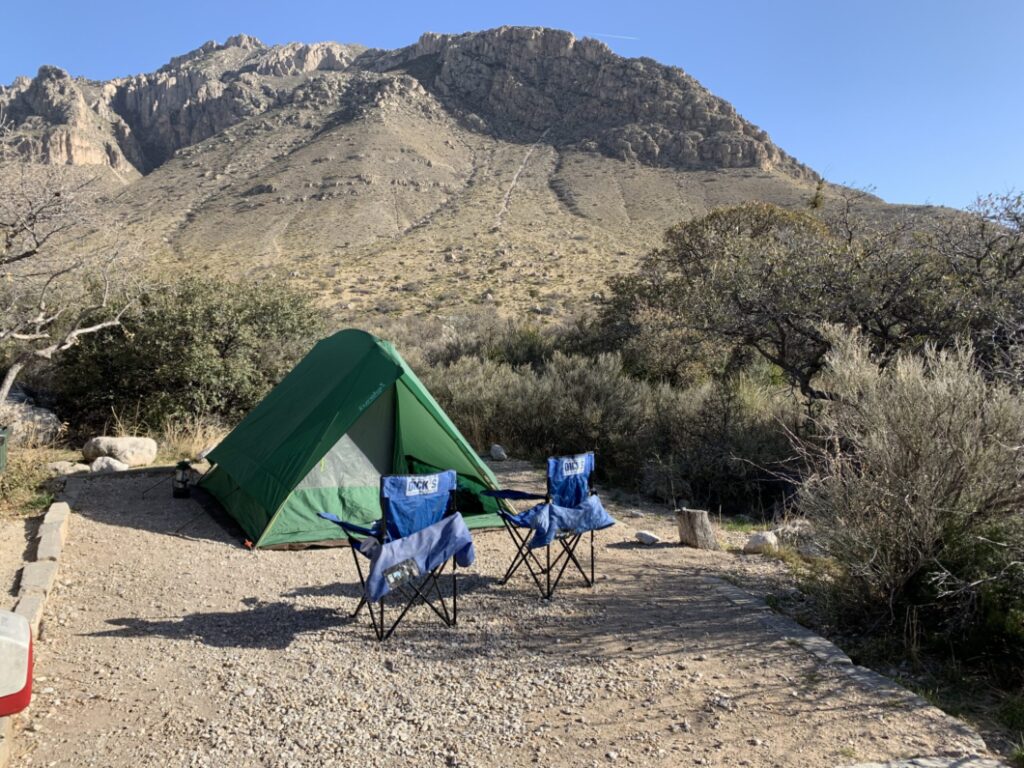
Pack Essential Camping and Hiking Gear
18 Carry a Navigation Device and a PLB when Backpacking
Pretty quickly, everything starts to look the same when hiking in the heat of the desert. Rain and wind can quickly obscure a trail. And if you wander off trail there are no clear markers to find it again. So don’t leave camp without a navigation device. And even better, take safety another step and pack a Personal Locator Beacon. The last place you want to be lost and unfindable is in the desert.
19 Pack Extra Batteries or Charger for Your Flashlight
You’re often a long way from any electricity source or store when camping in the desert. Make sure you have extra flashlights, batteries or a remote charger. We prefer to take long life rechargeable flashlights for hiking.
20 Bring a Good Multitool
Something always needs to be fixed when you camping. The only difference with camping in the desert is you are usually far away from everywhere. A great multitool, like a high quality Leatherman, will perform a variety of functions for you while taking up very little space. Check out our guide to the Best Camping Multitools.
21 Bring a Tent and Sleeping Bag Repair Kit
The best way to keep little critters and bugs out of your tent or sleeping bag is to keep it secure. Be ready to patch up your tent or sleeping bag if it gets a little tear.
Avoid Desert House Guests: Scorpions, Snakes and Other Critters of the Desert
22 Check your tent, sleeping bag and shoes for little critters
Maybe I’ve watched too many old westerns, but one of my desert camping fears is to find a rattlesnake in my sleeping bag. So before I go to bed each night I turn the bag inside out to check for any uninvited guests.
I may be a little paranoid, but it really is a good practice to check your tent, sleeping bag and shoes for little critters. Also keeping a clean tent space avoids places critters can easily hide also helps. Most important, keep your tent zipped up at all times so no one wanders in.
23 Store Food where animals can’t reach
I feel like this is so obvious, but them I’m amazed every time I see campers with coolers and food bags just laying around camp. Could you possibly advertise more to all the critters in the desert that you have a buffet waiting for them?
24 Pack out or bury your Poop
Human waste is just as attractive to wildlife as your food. Bring a folding shovel or hiking trowel so you can bury your waste at least 200 feet from your campsite in a whole that is 6 to 8 inches deep. Even better, pack it out with you!
Be Aware of the Weather When Camping in the Desert
25 Check the Weather Report for Rain and Flash Flooding Alerts
We talked a little about this when selecting your campsite. Don’t’ underestimate the danger of flash floods on your hiking plans for the day.
26 Also Watch for Forecasted High Winds and Sand Storms
Sand storms are hard on your body and on your camping equipment. If you see a forecast of high winds, batten down all your gear.
27 Be Prepared for Cold Temps at Night
Night temperatures in the desert can drop significantly. According to NASA Earth Observatory, “The temperature in the desert can change drastically from day to night because the air is so dry that heat escapes rapidly at night.” Additionally sand doesn’t hold heat, it only reflects the sun’s heat during the day. So once the sun is gone the ground cools quickly.
How much the temperature drops depends on a lot of environmental factors but on any one day it can be anywhere between 25 to 60 degree drop. So imagine you are hiking in 95 degree heat all day and then while you are sleeping the temperature drops to 45 degrees. Check our our guide to How to Keep Warm in a Tent for more ideas.
28 Know the Expected Extreme Hot Temps
There’s hot and then there’s beyond hot. Even in the desert there are days that get hotter than normal. If you watch the weather forecast you can plan your activities around those days. That super hot day might be a good time to explore a river hike or to head into town for supplies.
29 Limit Your Mid-Day activities
The sun between 10 and 2 is intense in the desert. If you are visiting a National Park or camping near a community, early afternoon is a great time to explore museums or go out for a long lunch. Plan your outdoor activities, like hikes, for early in the morning or late in the afternoon. And, if you are backpacking, find shade or put up a tarp and use the mid afternoon for a quick nap.
Take Care of Your Body in the Desert
30 Pack Plenty of Sun Screen
This should go without saying, but someone always forgets their sunscreen. It’s the reflection of the sun off the sand that catches people unaware. The sand magnifies the intensity of the sun’s UV rays just like water.
31 Take a Hat Made for Hot Weather
As you’d expect, the best hat for the desert has a wide brim to protect your face and neck. However what makes it special is the venting to let heat escape.
32 Shop for UFP/SPF Clothing
Once crazy expensive, you can now find UFP/SPF clothing for hiking at very reasonable prices. These fabrics stop harmful rays from passing through to your skin.
33 Wear Long Sleeves
Surprisingly covering your arms with light colored loose sleeves will keep you cooler than bare arms. The fabric not only protects from sunburn, it will reflect the sun and keep your skin from overheating. Just make sure you wear a breathable fabric so you are not holding in heat and sweat.
Personally I like layering a loose white UFP shirt over a tank top when hiking in the desert. Then if we find shade, I can take the outer shirt off for more cooling.
34 Wear Boots (not sandals)
You need good foot support in the desert because sandy ground shifts, causing your foot to twist and turn as you walk. Good support will minimize that action and keep your feet and ankles healthy. Boots will maximize support.
However, I will confess that I prefer a good pair of hiking shoes over boots even in the desert. The only real downside is that I get a lot more sand in my shoes than you would with the higher ankle coverage of boots.
If you want sandals to wear around camp, look for good hiking sandals, like TEVAS that will provide support.
35 Pack Baby Wipes to Wash Away Desert Sand
Somehow sand manages to get into every crack and crevice of your body when you are camping in the desert. Your most private body parts will really appreciate a wipe down before you go to bed at night.
Your Desert First Aid Kit
36 Plan for Dry Sinus Relief
Dry air is hard on your sinus. Carrying an inexpensive bottle of nasal saline spray has been a life saver for me many times, giving relief from that dry sinus pain. Also pack allergy medication for relief if your sinus get inflamed.
37 Protect Your Eyes
Obviously you need a good pair of sunglasses in the desert. But consider a pair that wrap around and protect your peripheral vision also. That sun is intense and you’ll be surprised how much pours in from the side.
Saline drops for your eyes are also a critical piece of my gear. When we were sledding in White Sands National Park, the high winds blew that fine sand right under my sunglasses. My eyes hurt so much from all the fine sand particles that I could hardly see. A few saline drops and you’ll be back in business.
38 Pack Insect Repellant and Bite Care
Yes, mosquitoes live in the desert. Their little eggs are quite hardy and are buried in sandy dry washes waiting for the next rain. Biting sand flies are among the many other small insects that can bite you while camping in the desert. So don’t forget your insect repellant and something to soothe bites.
We have a detailed guide on keeping mosquitoes away while camping that will help you avoid those nasty critters.
39 Don’t forget your Basic First Aid Kit
Of course, don’t forget your regular first aid kit for hiking and camping. You never know when you need a bandage, will get a nasty blister, or wake up with a raging headache.
Heat Stroke, Cramps and Exhaustion and Dehydration
40 Know the signs of Heat Stroke when Hiking in the Desert
When your body’s natural cooling system fails, you can become seriously ill and perhaps die.
Listen to your body and know the signs that heat stroke is coming on before it gets serious. For me, I start to feel lightheaded and a bit disoriented. If I stop right then and take cooling action I can recover quickly. The worse thing to do is to try to “push through it”.
Here’s a great resource from John Hopkins to help you learn the signs.
41 Know What to Do if You Overheat
It’s important to take actions that will cool your body as quickly as possible. Obviously move to shade if possible. Cool down by placing a wet cooling towel, bandana or even a shirt around your neck. Apply cold water to your wrists, armpits and groin.
42 Learn How to Avoid Overheating in the Desert
Here’s a few tip to avoid
- If you aren’t used to hot weather, take a few days to acclimatize your body to the hotter temperatures before you start your camping trip.
- Carry a wet bandana or towel in your backpack if you go hiking so you can wrap around your neck in the heat of the day.
- Take the lead of Southwestern US natives and enjoy that afternoon nap avoiding the heat of the day.
- Drink water slowly throughout the day.
43 Travel with a Buddy
Heat stroke can sneak up on you and be completely debilitating. Traveling with a buddy means someone has your back in an emergency.
Camping in the Desert Requires Extra Care of Your Electronics
44 Use Solar Power to Recharge
When you have all the sun you could ever want, go solar! Little solar packs are incredibly successful in the desert.
45 Protect your Electronics from Sand and Dust
Just as sand and dust work their way into your body crevices, it does the same with your electronics. When not in use, tuck your electronics into your bag or tent to minimize the damage those tiny sand particles can do.
Before You Go – Is your Vehicle Ready for the Desert?
46 Get a Vehicle Check up Before Camping in The Desert
I’m sure you’ve heard the horror tales of someone’s car overheating on a desert road and no one drove by for hours to help. Don’t let that be you. Have your vehicle or camper checked out before you go.
47 Carry Tools, Coolant and Oil for Your Vehicle
Even if you are not mechanically inclined, you can add coolant to an overheated engine. And even if you have no skill, the next car that stops might have a passenger that knows how to help you. Bring the basics with you.
48 Check Your Spare Tire
Take a few seconds and check the air pressure in your spare tire before you head out to the desert. If it’s low, get that tire checked out too. Dark, desert highways are not the place to wait for road side assistance to drive a 100 miles to help you. That is assuming you have cell service to call them.
49 Fill er up
Rule of thumb is never let your gas gauge go under ½ tank. Gas stations can be very far apart in desert country. If you are planning an extended desert road trip you might want to carry an extra gas tank for back up.
Bonus Tip: Bring a Novel Set in a National Park
When trying to beat the afternoon heat, grab a book that is set in a National Park. Relax and explore virtually!
Wrapping Up our Tips for Camping in the Desert
I hope a few of these camping in the desert tips are exactly what you need to turn your trip into an amazing experience. We almost forgot the most important tip, don’t forget your camera. You will have such a great time, see so many unusual things and love the views that you’ll want to fill up that camera with memories of your fantastic desert camping trip!:
